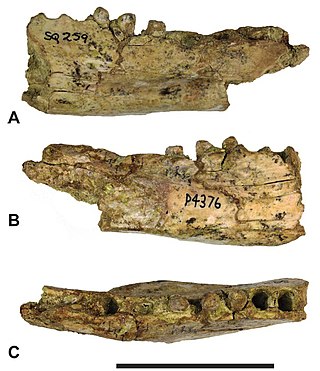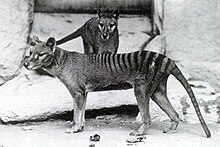
The thylacine, also commonly known as the Tasmanian tiger or Tasmanian wolf, is an extinct carnivorous marsupial that was native to the Australian mainland and the islands of Tasmania and New Guinea. The thylacine died out on New Guinea and mainland Australia around 3,600–3,200 years ago, prior to the arrival of Europeans, possibly because of the introduction of the dingo, whose earliest record dates to around the same time, but which never reached Tasmania. Prior to European settlement, around 5,000 remained in the wild on Tasmania. Beginning in the nineteenth century, they were perceived as a threat to the livestock of farmers and bounty hunting was introduced. The last known of its species died in 1936 at Hobart Zoo in Tasmania. The thylacine is widespread in popular culture and is a cultural icon in Australia.

The order Peramelemorphia includes the bandicoots and bilbies. All members of the order are endemic to Australia-New Guinea and most have the characteristic bandicoot shape: a plump, arch-backed body with a long, delicately tapering snout, very large upright ears, relatively long, thin legs, and a thin tail. Their size varies from about 140 grams up to 4 kilograms, but most species are about one kilogram.

Thylacinus is a genus of extinct carnivorous marsupials in the family Thylacinidae. The only recent member was the thylacine, commonly also known as the Tasmanian tiger or Tasmanian wolf. The last known Tasmanian tiger was in the Beaumaris Zoo in Tasmania, eventually passing away in 1936. The earliest known member of the genus, Thylacinus macknessi appeared during the Early Miocene, around 16 million years ago, and was smaller than the modern thylacine, with a body mass of about 6.7–9.0 kilograms (14.8–19.8 lb). Thylacinus represented the only extant genus of the family after the beginning of the Pliocene around 5 million years ago. Over time members of the genus saw an increase in body mass and a greater adaption to hypercarnivory in their dental morphology.

Riversleigh World Heritage Area is Australia's most famous fossil location, recognised for the series of well preserved fossils deposited from the Late Oligocene to more recent geological periods. The fossiliferous limestone system is located near the Gregory River in the north-west of Queensland, an environment that was once a very wet rainforest that became more arid as the Gondwanan land masses separated and the Australian continent moved north. The approximately 100 square kilometres (39 sq mi) area has fossil remains of ancient mammals, birds, and reptiles of the Oligocene and Miocene ages, many of which were discovered and are only known from the Riversleigh area; the species that have occurred there are known as the Riversleigh fauna.

Thylacinus potens was the largest species of the family Thylacinidae, originally known from a single poorly preserved fossil discovered by Michael O. Woodburne in 1967 in a Late Miocene locality near Alice Springs, Northern Territory. It preceded the most recent species of thylacine by 4–6 million years, and was 5% bigger, was more robust and had a shorter, broader skull. Its size is estimated to be similar to that of a grey wolf; the head and body together were around 5 feet long, and its teeth were less adapted for shearing compared to those of the now-extinct thylacine.
Badjcinus turnbulli is an extinct thylacinid marsupial.

Wakaleo is an extinct genus of medium-sized thylacoleonids that lived in Australia in the Late Oligocene and Miocene Epochs. Although much smaller than its close relative, the marsupial lion, Wakaleo would have been a successful hunter. It had teeth specially designed for cutting and stabbing. The genus is from an extinct family of Vombatiformes, so it is distantly related to the herbivorous wombats.

The genus Nimbacinus contains two species of carnivorous, quadrupedal marsupials in Australia both of which are extinct:
Thylacinus macknessi lived during the early Miocene and is the oldest known member of the genus Thylacinus. It is named after Brian Mackness, a supporter of Australian vertebrate paleontology.

Thylacinus megiriani lived during the late Miocene, 8 million years ago; the area T. megiriani inhabited in the Northern Territory was covered in forest with a permanent supply of water.
Maximucinus muirheadae is the largest known thylacinid species that lived in Queensland, Australia from the late Oligocene to the middle Miocene. The species was a quadrupedal marsupial predator, that in appearance looked similar to a dog with a long snout. Its molar teeth were specialized for carnivory; the cups and crest were reduced or elongated to give the molars a cutting blade. It is estimated to have weighed about 18 kilograms.
Muribacinus gadiyuli lived during the middle Miocene in Riversleigh. The species name comes from Wanyi aboriginal word for "little", in reference to its considerably small size compared to the modern thylacine and was similar in size to a fox-terrier dog, and "father" for the ancestral characteristics of the fossilised teeth.
Mutpuracinus archibaldi is an extinct carnivorous, quadrupedal marsupial that lived during the middle Miocene and is the smallest known thylacinid at approximately 1.1 kilograms, the size of a quoll, though, more closely related to the recently extinct thylacine.
Ngamalacinus timmulvaneyi lived during the early Miocene and has been found in Riversleigh.
Tyarrpecinus rothi is an extinct thylacinid marsupial that lived during the late Miocene and has been found at the Alcoota scientific reserve in the Northern Territory. The specific name honors Karl Roth for his contributions to the natural history of central Australia.
Wabulacinus ridei lived during the early Miocene in Riversleigh. It is named after David Ride, who made the first revision of thylacinid fossils. The material was found in system C of the Camel Spurtum assembledge.
The Macropodidae are an extant family of marsupial with the distinction of the ability to move bipedally on the hind legs, sometimes by jumping, as well as quadrupedally. They are herbivores, but some fossil genera like Ekaltadeta are hypothesised to have been carnivores. The taxonomic affiliations within the family and with other groups of marsupials is still in flux.
Riversleigh fauna is the collective term for any species of animal identified in fossil sites located in the Riversleigh World Heritage Area.
Thylacinus yorkellus is a fossil species of carnivorous marsupial, a sister species of the recently extinct Thylacinus cynocephalus, the Tasmanian tiger, both of which existed on mainland Australia.
William D. Turnbull (1922-2011) was an American paleontologist associated with the Chicago Field Museum. He published over 100 papers on mammals, continuing after his retirement as the museum's curator of mammals. He searched in Australia for evidence of recently extinct species, and made frequent expeditions to sites at the Washakie Formation in southwest Wyoming. His studies are considered significant contributions to the paleontology and biogeography of dinosaurs and Eocene mammals.











